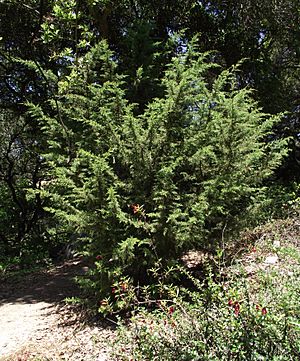Cupressus goveniana facts for kids
Quick facts for kids Cupressus goveniana |
|
|---|---|
 |
|
| Conservation status | |
| Scientific classification | |
| Genus: |
Cupressus
|
| Species: |
goveniana
|
 |
|
| Natural range of Hesperocyparis goveniana (sensu stricto) | |
| Synonyms | |
|
Synonymy
Hesperocyparis goveniana (Gordon) Bartel, current botanical name.
Callitropsis goveniana (Gordon) D.P.Little Cupressus aromatica Gordon Cupressus attenuata Gordon Cupressus bourgeauii Gordon Cupressus californica Carrière Cupressus cornuta Carrière Cupressus goveniana Gordon Cupressus pigmaea (Lemmon) Sarg. Cupressus silbae B.Huang bis Hesperocyparis pigmaea (Lemmon) Bartel Juniperus aromatica Carrière Neocupressus goveniana (Gordon) de Laub. |
|
The Gowen cypress, also known as the Californian cypress, is a special type of tree. Its scientific name is Hesperocyparis goveniana. This tree is endemic to California. This means it naturally grows only in California and nowhere else in the world.
Contents
Where the Gowen Cypress Lives
This tree lives only in a small area of California. You can find it on the Monterey Peninsula, near the coast. It doesn't grow in big forests. Instead, it lives in small groups. Sometimes, it even grows next to another cypress tree called the Monterey cypress. Sadly, the Gowen cypress is an endangered species. This means it's at risk of disappearing forever.
What the Gowen Cypress Looks Like
The Gowen cypress is an evergreen tree. This means its leaves stay green all year long. The tree can be very different in size. Some mature trees are less than 1 meter (about 3 feet) tall. But in perfect conditions, they can grow up to 50 meters (about 164 feet) tall!
Leaves and Cones
The leaves of the Gowen cypress grow in thick bunches. They are usually dark green or a bit yellow-green. The leaves are small and flat, like scales, about 2 to 5 millimeters long.
The tree produces special seed holders called cones. These cones are round or oval-shaped. They are about 11 to 22 millimeters long and have 6 to 10 scales. When they first grow, they are green. After about 20 to 24 months, they turn brown or gray-brown.
How Wildfires Help
A cool fact about these cones is that they stay closed for many years! They only open up after a wildfire burns the parent tree. This helps the seeds spread onto the bare ground left by the fire. This way, new trees can start to grow. The male cones are smaller, about 3 to 5 millimeters long. They release pollen in February or March.
Tree Family and Names
The Gowen cypress was once called Cupressus goveniana. But now, scientists have reclassified it as Hesperocyparis goveniana. This means it's in a slightly different group of cypress trees.
Related Cypress Trees
Some other cypress trees were once thought to be varieties of the Gowen cypress. But now, they are considered their own separate species:
- The Mendocino cypress (Hesperocyparis pygmaea) is a vulnerable species. It lives in Mendocino and Sonoma counties, closer to the coast.
- The Santa Cruz cypress (Hesperocyparis abramsiana) is an endangered species. It lives in Santa Cruz and San Mateo counties, in the Santa Cruz Mountains.


